
Recipes, Techniques, and Traditions from around the World”
By Sandor Ellix Katz
Chelsea Green Publishing, 2021
333 pages, hardcover, $35
“Sandor Katz’s Fermentation Journeys” brings us around the world, from the tropics to the Arctic, where the bestselling author’s notoriety leads him down back paths and opens doors to places, people and fermenting practices that most travelers do not get to experience.
Reading this book filled me with a strong sense of interconnectedness, bringing to mind our seed journeys, the ways in which humans grow food and how we prepare it, and how we preserve it so that it sustains us for more than a few days. Katz writes, “Because you are a human being on planet Earth—wherever you are from, and wherever you live—fermentation is a part of your birthright and cultural inheritance.” We are connected by curiosity, a love of learning and experimentation, by the science of life, by the food we eat.
You do not have to travel the world to learn fermentation techniques. The foundations are the same everywhere. People ferment what is abundant, with organisms naturally present where they live, in vessels that are readily available. But many traditional practices are disappearing with the influx of commercially available foods. We can learn them and pass them along.
Organized not by country but by fermentation substrates, the seven chapters cover simple sugars, vegetables, grains and starchy tubers, mold cultures, beans and seeds, milk, and meat and fish. The first stops on the journey are Niger, Burma and Indonesia to learn about palm wine (which is the ferment that started Katz’s life of learning and experimentation). Then on to Mexico for pulque, the fermented sap of maguey (Agave americana).
We globe-hop fermentation traditions through 60 recipes. Each is enriched with the story of place and its people and some of the reasons for or history around the technique. The photographs drew me in, making me want to be there to help grind the corn, stir the mash, taste, ask questions and soak in a world far from my fermentation ventures.
Stops include Burma for lahpet, fermented tea leaves; China for rice alcohol and dofuru, or fermented tofu; Japan for shio-koji and sake; Croatia for ajvar and whole sour cabbages; Thailand for naem, ribs fermented in salt, rice paste and garlic; Nigeria for efo riro spinach stew; and the United States for ricotta “miso.”
Katz calls himself a generalist — a self-taught studier of fermentation — but not an expert on any of it. He wants you to be inspired to use these techniques on the foods that are abundant around you. He recognizes that his knowledge of cultural traditions is superficial compared with the people who live them. His goal is to spread enthusiasm for a world of similarities in a diverse world of fermentation practices. He tries to be aware and sensitive and is open to more details or knowledge of any cultural practices that he writes about.
This book will feed your soul and your body in such healthful ways.
Roberta Bailey, Vassalboro, Maine
